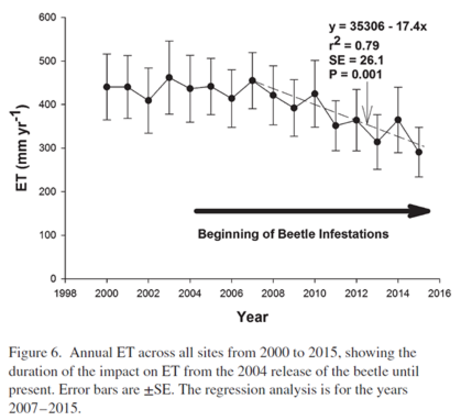Northern tamarisk beetles (Diorhabda carinulata) were released in the Upper Colorado River Basin in 2004–2007 to defoliate introduced tamarisk shrubs (Tamarix spp.) in the region’s riparian zones. The primary purpose was to control the invasive shrub and reduce evapotranspiration (ET) by tamarisk in an attempt to increase stream flows. USGS scientists evaluated beetle-tamarisk interactions with MODIS and Landsat imagery on 13 river systems, with vegetation indices used as indicators of the extent of defoliation and ET. Beetles are widespread and exhibit a pattern of colonize-defoliate-emigrate, so that riparian zones contain a mosaic of completely defoliated, partially defoliated, and re-foliated tamarisk stands. Based on satellite data and ET algorithms, mean ET before beetle release (2000–2006) was 416 mm/year compared to post-release (2007–2015) ET of 355 mm/year (P 0.05) for a net reduction of 61 mm/year . This reduction is lower than initial literature projections that ET would be reduced by 300–460 mm/year . Lower-than-expected ET reductions were caused by baseline ET rates being lower than initially projected; percentage ET reduction was low because tamarisk stands tend to regrow new leaves after defoliation and other plants help maintain canopy cover. Overall reductions in tamarisk green foliage during the study are 21%. However, ET in the Upper Basin has shown a steady decline since 2007 and equilibrium has not yet been reached. Defoliation is now proceeding from the Upper Basin into the Lower Basin at a rate of 40 km/year , much faster than initially projected.

Major sampling sites for defoliation trends and evapotranspiration across the Colorado River Basin.

